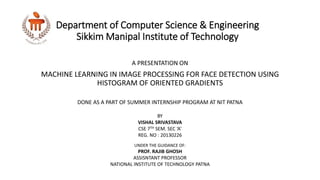This document summarizes a presentation on using histogram of oriented gradients (HOG) for face detection in machine learning image processing. It discusses preprocessing images, extracting HOG features, training a support vector machine classifier on 80% of images and testing it on 20%. Results show the classifier can correctly and incorrectly match faces. HOG features capture edge orientations to describe shapes and SVM classification maps examples to space divided by a gap to predict categories.







![FEATURE EXTRACTION AND TRAINING
EXTRACTING HOG FEATURES
The Computer Vision API for MATLAB provides for
the necessary tools the extract the HOG Features
for a given Image sample. Following is the Code
with the detailed explanation for the same.
extractHOGFeatures
• Extract histogram of oriented gradients (HOG)
features
• o Syntax
• features = extractHOGFeatures(I)
• [features,validPoints] =
extractHOGFeatures(I,points)
• [___, visualization] =
extractHOGFeatures(I,___)
• [___] = extractHOGFeatures(___,Name,Value)](https://image.slidesharecdn.com/08cd56c9-4186-4ad0-b22f-19286dd0b80d-161019090739/85/INTERNSHIP-8-320.jpg)
![TRAINING & PARTITIONING
• The most important part for preparing a learning model is training the classifier.
• The database is partitioned into 2 parts as:
• Training Set (80 %)
• Testing Set (20 %)
• This means that 80 % of the data (images) of every individual are used for preparing the training
data-set and rest 20 % is used for testing the Algorithm.
• The following code illustrates the portioning of the database:
• % Splitting database in Training Sets & Test Sets
• [training,test]=partition(facedatabase,[0.8 0.2]);](https://image.slidesharecdn.com/08cd56c9-4186-4ad0-b22f-19286dd0b80d-161019090739/85/INTERNSHIP-9-320.jpg)








